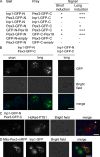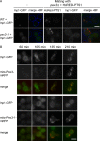A dual function for Pex3p in peroxisome formation and inheritance
- PMID: 19948495
- PMCID: PMC2779223
- DOI: 10.1083/jcb.200906161
A dual function for Pex3p in peroxisome formation and inheritance
Abstract
Saccharomyces cerevisiae Pex3p has been shown to act at the ER during de novo peroxisome formation. However, its steady state is at the peroxisomal membrane, where its role is debated. Here we show that Pex3p has a dual function: one in peroxisome formation and one in peroxisome segregation. We show that the peroxisome retention factor Inp1p interacts physically with Pex3p in vitro and in vivo, and split-GFP analysis shows that the site of interaction is the peroxisomal membrane. Furthermore, we have generated PEX3 alleles that support peroxisome formation but fail to support recruitment of Inp1p to peroxisomes, and as a consequence are affected in peroxisome segregation. We conclude that Pex3p functions as an anchor for Inp1p at the peroxisomal membrane, and that this function is independent of its role at the ER in peroxisome biogenesis.
Figures





Similar articles
-
An ER-peroxisome tether exerts peroxisome population control in yeast.EMBO J. 2013 Sep 11;32(18):2439-53. doi: 10.1038/emboj.2013.170. Epub 2013 Jul 30. EMBO J. 2013. PMID: 23900285 Free PMC article.
-
Determinants of the assembly, integrity and maintenance of the endoplasmic reticulum-peroxisome tether.Traffic. 2019 Mar;20(3):213-225. doi: 10.1111/tra.12635. Epub 2019 Jan 15. Traffic. 2019. PMID: 30597694
-
Inp1p is a peroxisomal membrane protein required for peroxisome inheritance in Saccharomyces cerevisiae.J Cell Biol. 2005 Jun 6;169(5):765-75. doi: 10.1083/jcb.200503083. Epub 2005 May 31. J Cell Biol. 2005. PMID: 15928207 Free PMC article.
-
Peroxisome membrane biogenesis: the stage is set.Curr Biol. 2004 May 25;14(10):R397-9. doi: 10.1016/j.cub.2004.05.017. Curr Biol. 2004. PMID: 15186768 Review.
-
Peroxisome biogenesis disorders: molecular basis for impaired peroxisomal membrane assembly: in metabolic functions and biogenesis of peroxisomes in health and disease.Biochim Biophys Acta. 2012 Sep;1822(9):1337-42. doi: 10.1016/j.bbadis.2012.06.004. Epub 2012 Jun 13. Biochim Biophys Acta. 2012. PMID: 22705440 Review.
Cited by
-
An ER-peroxisome tether exerts peroxisome population control in yeast.EMBO J. 2013 Sep 11;32(18):2439-53. doi: 10.1038/emboj.2013.170. Epub 2013 Jul 30. EMBO J. 2013. PMID: 23900285 Free PMC article.
-
Characterization of survival and stress resistance in S. cerevisiae mutants affected in peroxisome inheritance and proliferation, Δinp1 and Δpex11.Folia Microbiol (Praha). 2020 Apr;65(2):423-429. doi: 10.1007/s12223-019-00724-0. Epub 2019 Jun 23. Folia Microbiol (Praha). 2020. PMID: 31273644
-
A subtle interplay between three Pex11 proteins shapes de novo formation and fission of peroxisomes.Traffic. 2012 Jan;13(1):157-67. doi: 10.1111/j.1600-0854.2011.01290.x. Epub 2011 Oct 20. Traffic. 2012. PMID: 21951626 Free PMC article.
-
From networks of protein interactions to networks of functional dependencies.BMC Syst Biol. 2012 May 20;6:44. doi: 10.1186/1752-0509-6-44. BMC Syst Biol. 2012. PMID: 22607727 Free PMC article.
-
Multiple pathways for protein transport to peroxisomes.J Mol Biol. 2015 Mar 27;427(6 Pt A):1176-90. doi: 10.1016/j.jmb.2015.02.005. Epub 2015 Feb 11. J Mol Biol. 2015. PMID: 25681696 Free PMC article. Review.
References
Publication types
MeSH terms
Substances
Grants and funding
LinkOut - more resources
Full Text Sources
Other Literature Sources
Molecular Biology Databases

